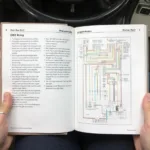A catalizador OBD2, or catalytic converter, plays a crucial role in your vehicle’s emissions system. It converts harmful pollutants into less harmful substances before they exit your tailpipe. Understanding how it works and interacts with your OBD2 system is essential for maintaining a healthy and environmentally friendly vehicle.
The Importance of a Functioning Catalizador OBD2
The catalytic converter is a key component in reducing your vehicle’s environmental impact. It transforms harmful gases like carbon monoxide, nitrogen oxides, and unburned hydrocarbons into less harmful carbon dioxide, nitrogen, and water vapor. A malfunctioning catalizador can lead to increased emissions, failed emissions tests, and even damage to other parts of your vehicle. This is where your OBD2 system comes in.
Your OBD2 system constantly monitors the efficiency of your catalizador. It does this by measuring the oxygen levels before and after the converter. A significant difference in these levels can indicate a problem with the catalizador, triggering an OBD2 code. These codes, such as P0420 (Catalyst System Efficiency Below Threshold (Bank 1)) or P0430 (Catalyst System Efficiency Below Threshold (Bank 2)), alert you to potential issues. Understanding these codes and their implications is vital for timely repairs and preventing further damage.
Common Causes of Catalizador OBD2 Issues
Several factors can contribute to a failing catalizador. One common culprit is a faulty oxygen sensor. A malfunctioning sensor can provide incorrect readings to the engine control unit (ECU), causing the engine to run rich or lean. This imbalance in the air-fuel mixture can overheat the catalizador, leading to its premature failure. Other causes include:
- Engine Misfires: Unburned fuel entering the exhaust system can damage the catalizador.
- Leaking Exhaust System: Leaks can introduce excess oxygen into the exhaust stream, affecting the catalizador’s performance.
- Oil Contamination: Burning oil can coat the catalizador, reducing its efficiency.
- Fuel Additives: Using incorrect fuel additives can also damage the catalizador.
Diagnosing Catalizador OBD2 Problems
Diagnosing a catalizador issue requires a multi-step approach. First, connect an OBD2 scanner to your vehicle’s diagnostic port. Retrieve any stored trouble codes and research their meaning. Codes like P0420 and P0430 specifically point to catalizador problems. However, other codes related to oxygen sensors, fuel system, or misfires can also indirectly indicate catalizador issues.
Next, visually inspect the catalizador for physical damage, such as cracks, dents, or melting. You can also check for exhaust leaks and unusual noises coming from the exhaust system. A professional mechanic can perform more advanced diagnostics, such as exhaust back pressure tests and temperature readings, to pinpoint the exact cause of the problem.
Preventing Catalizador OBD2 Problems
Maintaining a healthy catalizador starts with regular vehicle maintenance. Ensure your engine is running smoothly by addressing misfires and other performance issues promptly. Regularly check for exhaust leaks and repair them as needed. Using the correct type of fuel and avoiding unnecessary fuel additives can also prolong the life of your catalizador. Regularly checking and replacing your oxygen sensors as recommended by the manufacturer can also prevent future problems.
Catalizador OBD2 Replacement and Costs
If your catalizador has failed, replacement is usually necessary. The cost of a new catalizador can vary depending on the make and model of your vehicle. Aftermarket catalizador are often less expensive than original equipment manufacturer (OEM) catalizador, but they may not offer the same level of performance or durability.
Conclusion
The catalizador OBD2 system is critical for maintaining a clean and efficient vehicle. Understanding how this system works and addressing issues promptly can save you money and contribute to a healthier environment. Regular maintenance, prompt diagnostics, and choosing the right replacement parts are crucial for keeping your catalizador in optimal condition and passing your emissions tests. Remember, a properly functioning catalizador is not just good for your car; it’s good for the planet.
FAQ
-
What is a catalizador OBD2?
A catalizador OBD2, or catalytic converter, is a device in your car’s exhaust system that converts harmful pollutants into less harmful substances. -
What are the signs of a bad catalizador?
Signs include a check engine light, decreased fuel economy, a sulfurous smell from the exhaust, and reduced engine performance. -
How much does it cost to replace a catalizador?
The cost varies depending on the make and model of your vehicle but can range from a few hundred to over a thousand dollars. -
Can I drive with a bad catalizador?
While you might be able to drive for a short time, it’s not recommended. A bad catalizador can cause further damage to your vehicle and increase emissions. -
How do I prevent catalizador problems?
Regular maintenance, including timely oil changes and spark plug replacements, can help prevent catalizador problems. -
What are the common OBD2 codes related to the catalizador?
Common codes include P0420 and P0430, which indicate low catalyst system efficiency. -
How does the OBD2 system monitor the catalizador?
It uses oxygen sensors before and after the catalizador to measure its efficiency.
For more information on OBD2 codes, check out our comprehensive guide: códigos obd2 en español gratis.
Common Catalizador OBD2 Scenarios
- Scenario 1: Check engine light comes on, and the OBD2 scanner shows a P0420 code. This likely indicates a problem with the catalytic converter.
- Scenario 2: You notice a rotten egg smell from your exhaust. This could be a sign of a failing catalytic converter.
- Scenario 3: Your car fails an emissions test. A faulty catalytic converter is a common reason for emissions test failures.
Further Reading and Resources
For more information about OBD2 systems and troubleshooting, you can visit our website for other helpful articles.
Contact us for assistance: WhatsApp: +1(641)206-8880, Email: [email protected] or visit our office at 789 Elm Street, San Francisco, CA 94102, USA. We have a 24/7 customer support team ready to help.

